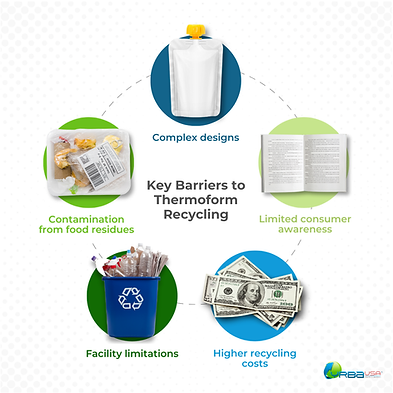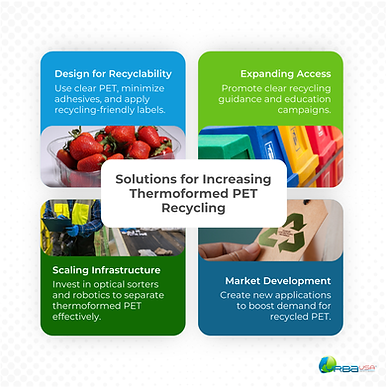.png)
Solving the Thermoform Recycling Problem
PET (Polyethylene terephthalate) is a plastic prized for its durability, clarity, and recyclability. While PET bottles have been a recycling success story for decades, thermoformed PET packaging—like clamshells and trays—has struggled to achieve similar recycling rates.
Back in 2023, U.S. recycling data highlighted a significant gap: only 9% of thermoformed PET was recovered, compared to about 27% of PET bottles. This disparity underscored systemic barriers in collection, sorting, and processing.
Today, the outlook is evolving. Industry collaboration, legislative changes, and technological advances are creating real momentum. The percentage of U.S. residents with access to recycling programs that allow thermoformed PET has risen to 54% by late 2024. This article examines the key challenges that have hindered PET thermoform recycling, while integrating the latest initiatives driving crucial improvements.
This article delves into:
1. Why Thermoforms Were Left Behind
2. Recent Progress on Thermoform Recycling
3. The End-Market Challenge and Opportunity
4. Solutions for Increasing Thermoformed PET Recycling
5. Conclusion
Why Thermoforms Were Left Behind
Even with PET’s inherent recyclability, thermoformed formats present a unique set of difficulties that have long limited their inclusion in the recycling stream.
1. Contamination from Design and Residue
Thermoforms often contain various contaminants that complicate recycling.
-
Adhesives and residues: Unlike bottles, thermoforms frequently come with stubborn adhesives and food residue. These can melt during reprocessing, compromising the quality of the final recycled plastic and potentially ruining an entire batch.
-
"Lookalike" polymers: Thermoforms can look deceptively similar to other plastics, such as polystyrene (PS) or polyvinyl chloride (PVC). When these "lookalikes" are mis-sorted, they can contaminate the PET recycling stream, rendering the material unusable for high-value applications.
.png)
2. Design Complexity and Heterogeneity
PET bottles are largely uniform in color and shape, making them easy to sort. Thermoforms, however, are a different story.
-
Varying forms and thickness: They range from flimsy blister packs to thick, rigid clamshells.
-
A rainbow of colors: They come in many different colors, including opaque or black, which older optical sorters struggle to recognize and separate.
This heterogeneity is a logistical nightmare for high-speed sorting lines, making it challenging to ensure a clean, homogeneous stream of material.
3. Limited and Legacy Infrastructure
For decades, Material Recovery Facilities (MRFs) were built and optimized for processing bottles and jars. Their equipment was calibrated to handle the shape and density of bottles. As a result, when a clamshell or tray entered the system, it was either misrouted into mixed-plastic bales or simply discarded and sent to a landfill. Without the technology to efficiently separate them, there was no business case for MRFs to accept thermoforms at scale.
4. Widespread Consumer Confusion
The lack of consistent recycling guidelines across the country has left consumers unsure about what belongs in the bin. The "chasing arrows" #1 symbol on a PET bottle is universally recognized, but the same symbol on a thermoform often comes with local caveats. This leads to "wish-cycling," where consumers toss items in the recycling bin hoping they're recyclable. This contributes to contamination and leaves a significant volume of viable PET material out of the recycling stream.
Recent Progress on Thermoform Recycling
.png)
PET bottles are largely uniform in color and shape, making them easy to sort. Thermoforms, however, are a different story.
While the barriers remain, several key shifts have created unprecedented momentum over the past two years.
Rising Access and Acceptance Rates
A key sign of progress is the rapid increase in recycling access. As of late 2024, data from The Recycling Partnership confirms that 54% of U.S. residents have access to recycling programs that accept PET thermoforms. This progress is the direct result of coordinated efforts.
The PET Recycling Coalition, for example, has set an ambitious target of 60% nationwide acceptance for all PET thermoforms by 2027, with a specific focus on achieving 60% acceptance for PET cups by the end of 2025.
Growth in Recycling Volumes
The success of these programs is reflected in the numbers. The recycling of PET thermoforms has tripled since 2011, reaching a significant milestone of 130 million pounds processed domestically in 2023, with an additional 38 million pounds exported. This dramatic growth demonstrates both a greater capture of material and rising demand for the recycled content.

Advancements in Sorting Technology
State-of-the-art MRFs are deploying cutting-edge optical sorters, sophisticated robotics, and AI-driven systems.
These new machines use Near-Infrared (NIR) technology to identify and separate different plastic polymers with greater precision than ever before, including distinguishing a PET thermoform from a bottle. Robotics and AI add another layer of precision, recognizing and picking out items by shape, size, and color.
Facilities such as Rumpke’s new Columbus, Ohio MRF are a testament to this, processing thermoforms at a scale previously unimaginable.
Supportive Legislation: The Rise of EPR
Extended Producer Responsibility (EPR) laws are reshaping accountability for packaging waste. These laws shift the financial and logistical burden of recycling from taxpayers to packaging producers. Critically, many EPR laws include "eco-modulation," providing a financial incentive for companies to design packaging that is easily recyclable. This is forcing brands to adopt more uniform designs to avoid higher fees.
California’s groundbreaking SB 54, for example, sets ambitious recycling rate targets for single-use plastic, creating a powerful mandate for industry to invest in solutions for materials like thermoforms.
Industry Collaboration
Organizations such as the PET Recycling Coalition and NAPCOR are channeling grants, research, and technical support directly into the recycling ecosystem. Their coordinated approach funds MRF upgrades, improves sortation systems, and builds robust networks between packaging producers, brands, and recyclers. This ensures investments are strategic and effective, helping to move thermoforms into the recycling stream at levels not seen before.
The End-Market Challenge and Opportunity
.png)
There is a rapidly growing demand from brands to meet ambitious recycled
Even with significant progress in collection and sorting, the final piece of the recycling puzzle is ensuring a strong, consistent end market for the material. For a material to be truly "recycled," it must be reprocessed into a new product.
For decades, the demand for recycled PET was dominated by the "bottle-to-bottle" market. Reclaimers were optimized to produce high-quality pellets for new beverage containers, and the presence of thermoforms was seen as a contaminant. This created a bottleneck: MRFs were hesitant to collect thermoforms if they couldn't find a buyer, and brands couldn't commit to using recycled thermoform content if the supply was unreliable.
Today, this is changing. There is a rapidly growing demand from brands to meet ambitious recycled content goals, driven by both voluntary commitments and legislative mandates. This new demand creates a "pull" from the market for all forms of recycled PET. Reclaimers are now investing in specialized equipment to process thermoforms and are exploring new opportunities to use the recycled material. While "thermoform-to-thermoform" recycling is challenging, the material is proving valuable for other high-value applications, including textiles, strapping, and durable goods.
Solutions for Increasing Thermoformed PET Recycling
To unlock the full potential of thermoformed PET recycling, sustained effort will be required across the entire value chain. A holistic approach is needed to connect design, collection, and market pull.
Key strategies include:
Design for Recyclability: Brands must continue to minimize adhesives and non-PET additives. Expanding the adoption of clear PET with compatible labeling will streamline sorting and reprocessing, enhancing efficiency and reducing costs across the entire supply chain.
Scaling Infrastructure: Investment in more MRF upgrades with optical and robotic sorting technologies is critical. Continued funding through initiatives like the PET Recycling Coalition is essential.
.png)
Expanding Consumer Access and Awareness: We need unified messaging and consistent recycling guidelines across municipalities. Consumer education campaigns can clarify the recyclability of clamshells and trays, driving up collection rates.
Market Development: The industry must build stronger end markets for recycled thermoformed PET, ensuring consistent demand and value. Highlighting its role in high-value applications beyond new packaging is key.
Conclusion
The story of thermoformed PET recycling is shifting from a problem to an achievable solution. While barriers such as contamination and infrastructure gaps persist, the combination of technology, supportive legislation, and unprecedented industry collaboration is creating real and measurable momentum.
Recycling rates for thermoformed PET are still lower than bottles, but acceptance is climbing steadily. With over half of U.S. residents now having access to curbside thermoform recycling and ambitious national targets guiding the way, the pathway to widespread recycling is clearer than ever before.
Continued investment, design innovation, and consumer participation will be critical in the years ahead. By aligning policy, infrastructure, and industry commitment, thermoformed PET can move closer to achieving its full circular potential, securing its place as a valuable resource in a sustainable economy.